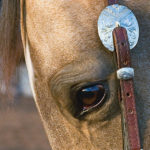This month we continue on our journey of seeking evenness in the torso. Last month, we focused mainly on the front of the body, predominantly working the abdominals. This month we will focus on strengthening the back.
As dressage riders, we require our spine to remain in a neutral position, where all the vertebrae are evenly stacked one upon the other. We need to maintain this dynamic balance as the horse moves under us. Much of our life is spent in flexion, so strengthening the back is beneficial for almost everyone.
In riding, there is no way you can give effective driving aids or half halts without good back strength. I say “strength,” but this strength also includes suppleness so you can subtly increase or decrease the engagement of your back muscles to communicate with your horse. You need to be able to both follow the swing of your horse in the trot but also the jump in the canter with a soft lower back as well as be able to indicate that you want him to come back and stay with you when you resist the forward movement with your body. You also have to be able to stay in sync and in balance with your horse and must be sure that you’re not inadvertently telling him to do something you don’t actually want just because you don’t have the postural strength to stay with him.
Horses, like humans, often like to take the easy way out. If they aren’t requested to go forward, many won’t offer to. Keep in mind that collection comes from activating the gait rather than slowing everything down. To maintain this, you need good back strength so that your horse cannot slow down, sucking your pelvis backward. Although your legs are also involved with this process, you need your back to act almost like the wall of a dam that allows the flow of energy forward but not backward. You always want to have the feeling that two-thirds of the horse is in front of you.
You also want your body to remain a little disassociated from your legs so that you can give leg aids without losing the length of your spine and balance and also so you can let your back go with the movement of the horse without moving your legs.
The following exercises will help you develop a stronger, more functional back, which will also help protect it from injury.
Swan with Roller
Setup:
• Lie on your tummy and find your neutral spine. Keep the lower part of your hands resting on the roller with your thumbs facing the ceiling and your tummy slightly lifted. You want to feel as if there is a little bird or something delicate under you that you don’t want to squash rather than just let your belly flop to the floor. This will help to support your back.
• Add lateral breathing.
• Switch off your global muscles, the lower half of your body.
• Switch on your core.
Instruction of Movement:
• Breathe in and roll your hands along the roller until your upper body is drawn down.
• Continue with your in-breath as you roll your hands along the roller and lift your upper body without straining your back and especially your lower back.
• Breathe out and slowly return to start.
Swimming
Setup:
• Find your neutral spine, as you lie on your tummy as you did in the previous exercise.
• Add lateral breathing.
• Switch on your core.
• Engage your back so you lift your head and all four of your limbs off the floor while still keeping them parallel to the floor. Use your glutes to help lift your legs and use your shoulders to lift your arms. Keep your knees and elbows straight.
Instruction of Movement:
• Lift one arm and the diagonal leg higher.
• Lower your limbs and then lift the opposite diagonal pair. Continue to repeat this but take it only as fast as you can keep your torso still and not swinging from side to side.
• Modification: If this movement is too strong, and you feel that you are straining in your lower back, keep an arm and leg on the ground as you lift the diagonally opposite limb or just move your arms or your legs.
Superman over the Ball
This is very similar to the swimming exercise, except you will perform the movement of diagonal leg-and-arm pairs while you are on top of a fitball, which adds a new level of instability. Don’t forget to support with your abs and enjoy the challenge.
Rebecca Ashton is a qualified Pilates instructor, a British Horse Society-trained instructor and an Equestrian Australia-accredited dressage coach. She has competed through Intermediaire II, working with riders such as Anky van Grunsven and earning championship titles in the small tour. She lives in Australia and teaches clinics internationally (equestelite.com).





